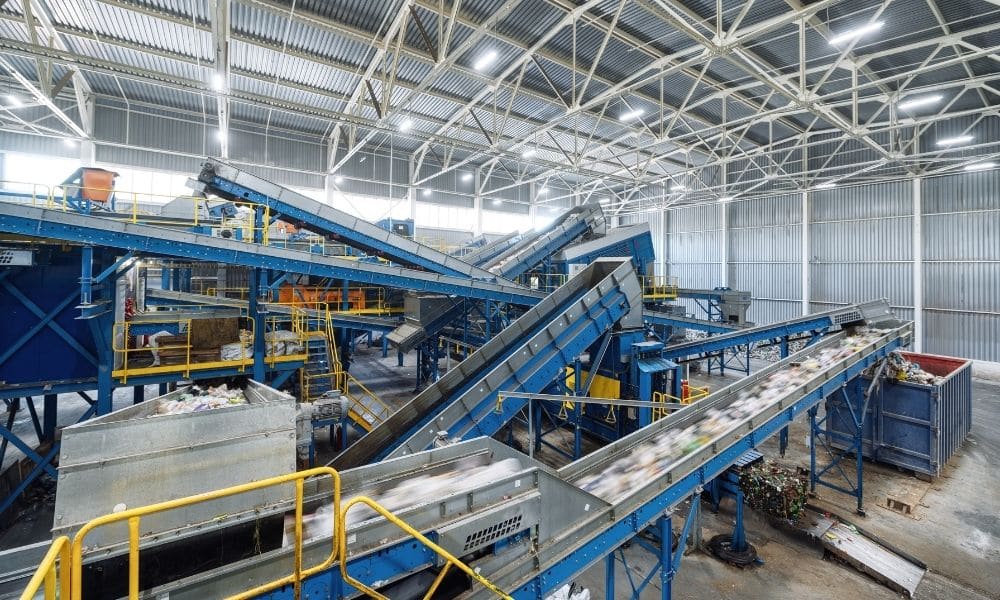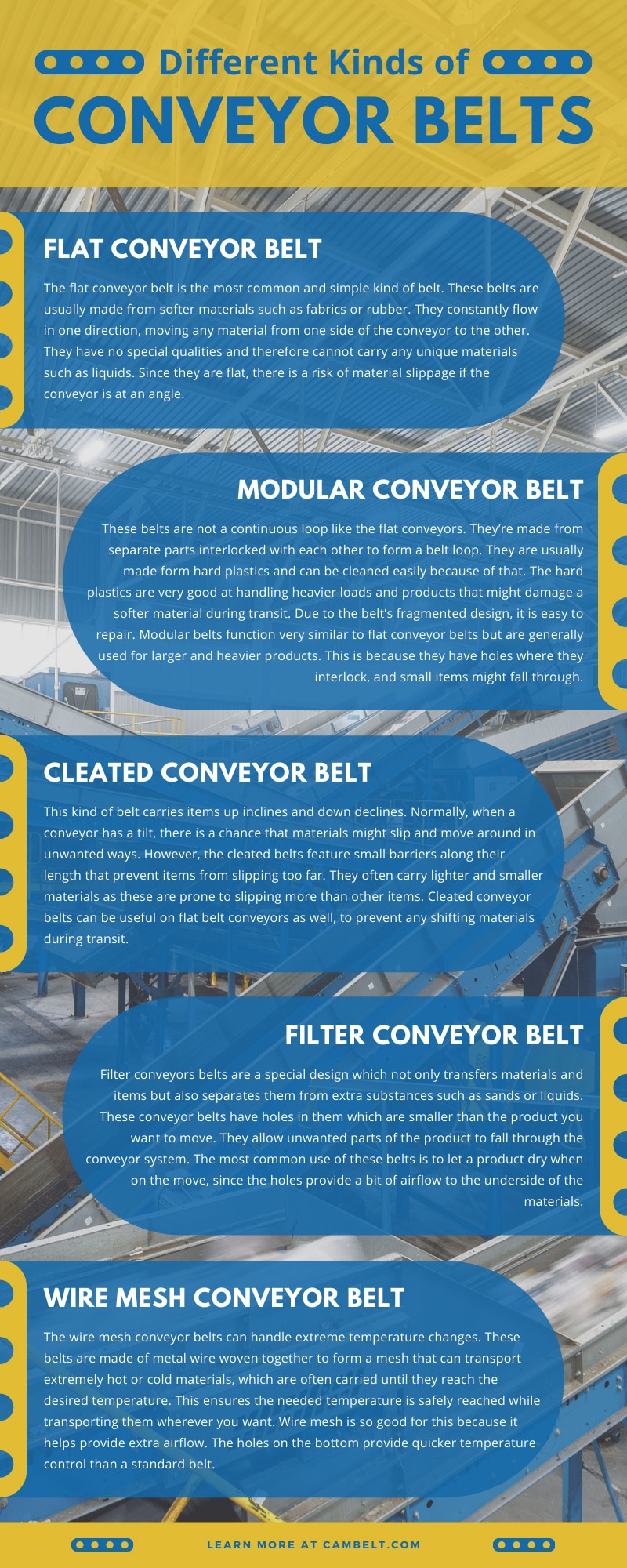
Just about every industry that has a physical product uses at least one belt conveyor at some point in the creation of that product. Belt conveyors are so useful at moving materials and items that it would be inefficient to use anything else. A conveyor belt is the moving part of the belt conveyor that carries the product or materials. There are many different types of conveyor belts to handle the wide variety of things that need to move.
Flat Conveyor Belt
The flat conveyor belt is the most common and simplest type of conveyor system. These belts are usually made from softer materials such as fabrics or rubber. They constantly flow in one direction, moving any material from one side of the conveyor to the other. They have no special qualities and therefore cannot carry any unique materials such as liquids. Since they are flat, there is a risk of material slippage if the conveyor is at an angle.
Modular Conveyor Belt
These belts are not a continuous loop like the flat conveyors. They’re made from separate parts interlocked with each other to form a belt loop. They are usually made form hard plastics and can be cleaned easily because of that. The hard plastics are very good at handling heavier loads and products that might damage a softer material during transit. Due to the belt’s fragmented design, it is easy to repair. Modular belts function very similar to flat conveyor belts but are generally used for larger and heavier products. This is because they have holes where they interlock, and small items might fall through.
Cleated Conveyor Belt
This type of conveyor belt carries items up inclines and down declines. Normally, when a conveyor has a tilt, there is a chance that materials might slip and move around in unwanted ways. However, the cleated belts feature small barriers along their length that prevent items from slipping too far. They often carry lighter and smaller materials as these are prone to slipping more than other items. Cleated conveyor belts can be useful on flat belt conveyors as well, to prevent any shifting materials during transit.
Filter Conveyor Belt
Filter conveyors belts are a special design which not only transfers materials and items but also separates them from extra substances such as sands or liquids. These conveyor belts have holes in them which are smaller than the product you want to move. They allow unwanted parts of the product to fall through the conveyor system. The most common use of these belts is to let a product dry when on the move, since the holes provide a bit of airflow to the underside of the materials.
Wire Mesh Conveyor Belt
The wire mesh conveyor belts can handle extreme temperature changes. These belts are made of metal wire woven together to form a mesh that can transport extremely hot or cold materials, which are often carried until they reach the desired temperature. This ensures the needed temperature is safely reached while transporting them wherever you want. Wire mesh is so good for this because it helps provide extra airflow. The holes on the bottom provide quicker temperature control than a standard belt.
Roller Top Conveyor Belt
A roller top conveyor belt is an odd-looking type of conveyor system. It’s a conveyor belt that has a bunch of ball bearing on top of it. The product slides across the ball bearings to a new destination. These systems are usually very good at moving larger loads that can be rough on normal conveyor belts. They can typically handle very heavy loads and can take quite a beating.
Types of Belt Conveyors and What They Can Use
Not only are there several different types of conveyor belts, but there are also different types of belt conveyors. Each has its own uses, and the types of conveyor belts that are compatible with them varies. Here are a few of the different options and what kind of belts are most useful on them.
Flat Belt Conveyor
A flat belt conveyor is as common as the flat conveyor belt. The standard for all moving conveyors, a flat belt conveyor moves items from point A to point B in a straight line. They use powerful rotors on either end of the conveyor to rotate the belt that sits on them. The belt loops around the conveyor, so as it turns, materials and products flow in that direction. Flat conveyors systems can use all kinds of belt conveyors; it depends mostly on the material and what it requires.
Inclined Belt Conveyor
An inclined belt conveyor is much like a flat belt conveyor except it’s on an incline. This means that it is meant to transport goods to a different height than where the items started. There is the risk of products slipping on these belts, so it’s generally used with belts that prevent items sliding off. The cleated conveyor belt is a great example of this.
Curved Belt Conveyor
This type of conveyor system looks exactly like it sounds. The conveyor bends to change the direction that the products flow. The amount of curve can vary from a small curve to a complete 180-degree turn. This kind of belt conveyor can only accept certain types of soft belts. Harder materials aren’t capable of handling more intense curves and can easily cause problems if used.
Sidewall Cleated Belt Conveyor
The sidewall cleated belt conveyor is a unique system that we specialize in at Cambelt International LLC. The conveyor is capable of moving materials up anything less than a 90-degree incline. These belt conveyors have large troughs that can carry large amounts of loose materials without causing them to slip. Due to the large walls surrounding the belt, each section is able to handle a lot more than a normal cleated belt conveyor. The sidewall also helps to prevent the materials from falling off the sides of the conveyor. The sidewall cleated belt conveyor is also quite nice, as it can reduce the number of conveyors you need overall. It generally features two flat conveyor sections along with the incline section, meaning that you do not need separate conveyors.
These are the most common types of conveyor belts that you can find. Others are more specific and can handle whatever you need moved. Just be sure to plan carefully when getting a conveyor system.

